Genus Porphyrio Phylum Chordata Rank Species | Family Rallidae Scientific name Porphyrio hochstetteri Higher classification Swamphen | |
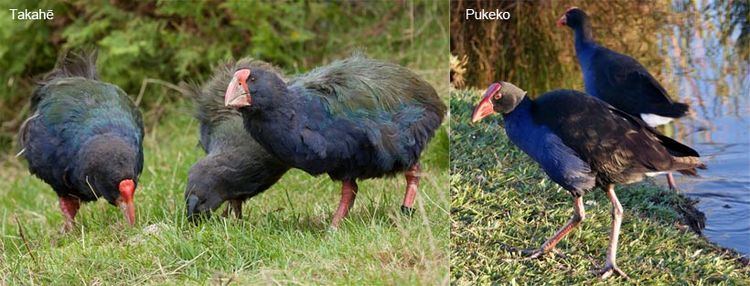 | ||
Similar Bird, Kakapo, Australasian swamphen, Swamphen, Weka | ||
Takah bird in te anau eating grass
The takahē, Notornis, or South Island takahē (Porphyrio hochstetteri), is a flightless bird indigenous to New Zealand and belonging to the rail family. It was thought to be extinct after the last four known specimens were taken in 1898. However, after a carefully planned search effort the bird was rediscovered by Geoffrey Orbell near Lake Te Anau in the Murchison Mountains, South Island, on 20 November 1948. The specific scientific name commemorates the Austrian geologist Ferdinand von Hochstetter.
Contents
- Takah bird in te anau eating grass
- Taxonomy and systematics
- Description
- Distribution and habitat
- Behaviour and ecology
- Breeding
- Status and conservation
- Decline of takah
- Takah population conservation and protection
- Future efforts for protection
- References
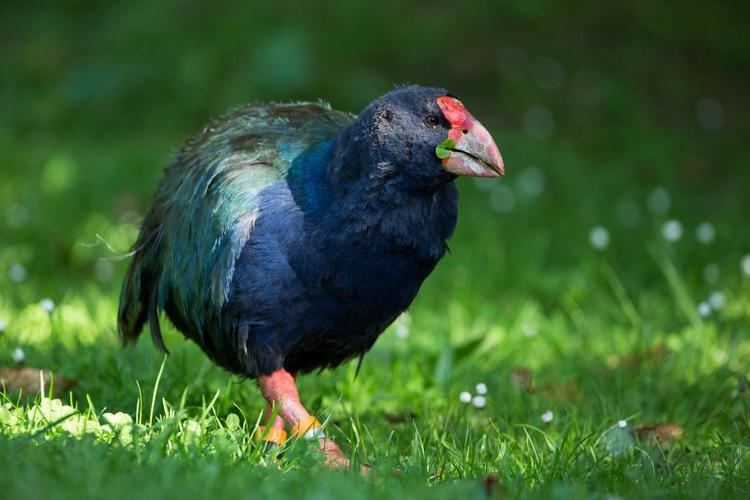
Taxonomy and systematics
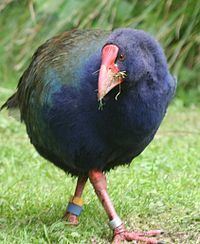
A related species, the North Island takahē (P. mantelli) or mōho is extinct and only known from skeletal remains. Both forms were long assumed to be subspecies of mantelli, and were usually placed in the genus Notornis. However, it has been determined that the differences between Porphyrio and Notornis were insufficient for separating the latter, whereas the differences between the North and South Island forms justified the splitting into two species, as each evolved independently towards flightlessness.
Description
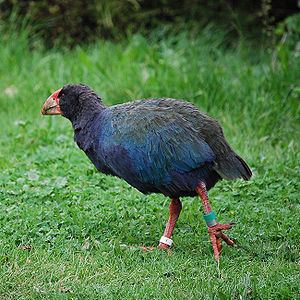
The takahē is the largest living member of the family Rallidae. Its overall length averages 63 cm (25 in) and its average weight is about 2.7 kg (6.0 lb) in males and 2.3 kg (5.1 lb) in females, ranging from 1.8–4.2 kg (4.0–9.3 lb). The standing height is around 50 cm (20 in). It is a stocky bird, with reduced wings, strong legs and a massive bill.

The adult takahē is mainly purple-blue in colour, with a greenish back and inner wings. It has a red frontal shield and red-based pink bill. The legs are pink. Sexes are similar, the females being slightly smaller, but young birds have mainly pale brown plumage. Immatures have a pinkish bill with bluish cast. This is a noisy species with a loud clowp call. The contact call is easily confused with that of the weka (Gallirallus australis), but is generally more resonant and deeper.
Distribution and habitat
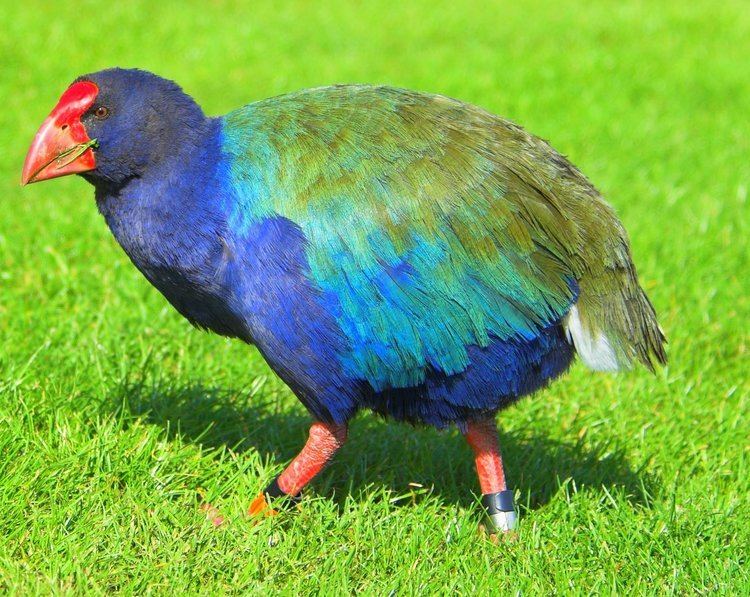
The species is still present in the location where it was rediscovered in the Murchison Mountains. Small numbers have also been successfully translocated to five predator-free offshore islands, Tiritiri Matangi, Kapiti, Maud, Mana and Motutapu, where they can be viewed by the public. Additionally, captive takahē can be viewed at Te Anau and Pukaha/Mt Bruce wildlife centres. In June 2006 a pair of takahē were relocated to the Maungatautari Restoration Project. In September 2010 a pair of takahē (Hamilton and Guy) were released at Willowbank Wildlife Reserve - the first non-Department of Conservation institution to hold this species. In January 2011 two takahē were released in Zealandia, Wellington, and in mid-2015, two more takahē were released on Rotoroa Island in the Hauraki Gulf. There have also been relocations onto the Tawharanui Peninsula. In 2014 two pair of Takahe were released into Wairakei golf and sanctuary, a private fenced sanctuary at Wairakei north of Taupo, the first chick was born there in November 2015. At the beginning of 2013 there were 263 takahē accounted for, showing slow but steady growth over the previous few years.
Behaviour and ecology
The takahē is a sedentary and flightless bird currently found in alpine grasslands habitats. Although it is indigenous to swamps, humans have turned its swampland habitats into farmland, and the takahē was forced to move upland into the grasslands. It is territorial and remains in the grassland until the arrival of snow, when it descends to the forest or scrub. It eats grass, shoots, and insects, but predominantly leaves of Chionochloa tussocks and other alpine grass species. The takahē can often be seen plucking a snow grass (Danthonia flavescens) stalk, taking it into one claw, and eating only the soft lower parts, which appears to be its favourite food, while the rest is discarded. A takahē has been recorded feeding on a paradise duckling at Zealandia. Although this behaviour was previously unknown, the related pukeko occasionally feeds on eggs and nestlings of other birds as well.
Breeding
The takahē is monogamous, with pairs remaining together from 12 years to, probably, their entire lives. It builds a bulky nest under bushes and scrub, and lays one to three buff eggs. The chick survival rate is 73-97%. Recently, human intervention has been required to maintain the breeding success of the takahē, which is relatively low in the wild compared to other, less threatened species, so methods such as the removal of infertile eggs from nests and the captive rearing of chicks have been introduced to manage the takahē population. The Fiordland takahē population has a successful degree of reproductive output due to these management methods: the number of chicks per pairing with infertile egg removal and captive rearing is 0.66, compared to 0.43 for regions without any breeding management.
Status and conservation
The near-extinction of the formerly widespread takahē is due to a number of factors: over-hunting, loss of habitat and introduced predators have all played a part. The introduction of red deer (Cervus elaphus) represent a severe competition for food, while the stoats (Mustela erminea) take a role as predators. The spread of the forests in post-glacial Pleistocene-Holocene has contributed to the reduction of habitat. Since the species is long-lived, reproduces slowly, takes several years to reach maturity, and had a large range that has drastically contracted in comparatively few generations, inbreeding depression is a significant problem. The recovery efforts are hampered especially by low fertility of the remaining birds. Genetic analyses have been employed to select captive breeding stock in an effort to preserve the maximum genetic diversity.
Decline of takahē
Takahē were assumed to be extinct but were rediscovered by Geoffrey Orbell near Lake Te Anau in the Murchison Mountains, South Island, New Zealand on 20 November 1948. Takahē were at one time present throughout this island country, but for several reasons ceased to be found, which made many think that they were wiped out. Many reasons were cited for the failure of this flightless bird. There are two significant periods when takahē numbers declined: Pre-European and Post-European arrival.
Reasons for the pre-European decline of takahē were postulated by Williams (1962) and later supported in a detailed report by Mills et al. (1984). They held that climate changes were the main cause of the failure in takahē before European settlement. The environmental variations before the European settlement were not suitable for takahē, and exterminated almost all of them. Survival in the altering temperature was not tolerable by this group of birds. Takahē live in alpine grasslands, but the post-glacial era destroyed those zones which caused an intense decline in their numbers.
Secondly, they suggested that Polynesian settlers arriving about 800–1000 years ago, bringing dogs and Polynesian rats and hunting takahē for food, started another decline. European settlement in the nineteenth century almost wiped them out through hunting and introducing mammals such as deer which competed for food and predators (e.g. stoats) which preyed on them directly.
Takahē population, conservation and protection
After long threats of extinction, takahē now find protection in Fiordland National Park (New Zealand’s largest national park). However, the species has not made a stable recovery in this habitat since they were rediscovered in 1948. In fact the takahē population was at 400 before it was reduced to 118 in 1982 due to competition with Fiordland domestic deer. Conservationists noticed the threat deer posed to takahē survival and the national park now implements deer control by hunting by helicopter.
The rediscovery of the takahē caused great public interest. The New Zealand government took immediate action by closing off a remote part of Fiordland National Park to prevent the birds from being bothered. However, at the moment of rediscovery, there were different perspectives on how the bird should be conserved. At first the Forest and Bird Society advocated for takahē to be left to work out their own “destiny”, but many worried that the takahē would be incapable of making a comeback and thus become extinct like New Zealand’s native huia. Interventionists then sought to relocate the takahē to “island sanctuaries” and breed them in captivity. However, no action was taken for nearly a decade due to a lack of resources and a desire to avoid conflict.
Biologists from the Department of Conservation drew on their experience with designing remote island sanctuaries to establish a safe habitat for takahē and translocate birds onto Maud Island (Malborough Sounds), Mana Island (near Wellington), Kapiti Island (Kapiti Coast), and Tiritiri Matangi Island (Hauraki Gulf). The success of these translocations has meant that the takahē's island metapopulation appears to have reached its carrying capacity, as revealed by the increasing ratio of non-breeding to breeding adults and declines in produced offspring. This may lead to reduced population growth rates and increased rates of inbreeding over time and pose problems regarding the maintenance of genetic diversity, and thus takahē survival in the long term.
Future efforts for protection
The original recovery strategies and goals set in the early 1980s, both long-term and short-term, are now well under way.
The programme to move takahē to predator-free island refuges, where the birds also receive supplementary feeding, began in 1984. Takahē can now be found on five small islands; Maud Island (Marlborough Sounds), Mana Island (off Wellington's west coast), Kapiti Island (off Wellington's west coast), Tiritiri Matangi Island (Hauraki Gulf) and Motutapu Island (Hauraki Gulf). The Department of Conservation also runs a captive breeding and rearing programme at the Burwood Breeding Centre near Te Anau which consists of five breeding pairs. Chicks are reared with minimal human contact. The offspring of the captive birds are used for new island releases and to add to the wild population in the Murchison Mountains. The Department of Conservation also manages wild takahē nests to boost the birds' recovery. Surplus eggs from wild nests are taken to the Burwood Breeding Centre.
An important management development has been the stringent control of deer in the Murchison Mountains and other takahē areas of Fiordland National Park. Following the introduction of deer hunting by helicopter, deer numbers have decreased dramatically and alpine vegetation is now recovering from years of heavy browsing. This improvement in its habitat has helped to increase takahē breeding success and survival. Current research aims to measure the impact of attacks by stoats and thus decide whether stoats are a significant problem requiring management.
One of the original long-term goals was to establish a self-sustaining population of well over 500 takahē. The population stood at 263 at the beginning of 2013. In 2015 300 Takahe remain.
